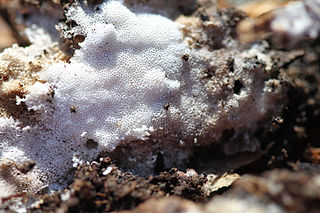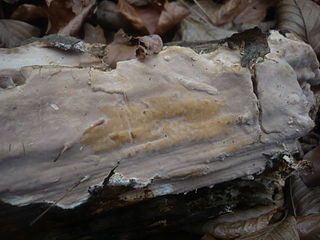
The Polyporaceae are a family of poroid fungi belonging to the Basidiomycota. The flesh of their fruit bodies varies from soft to very tough. Most members of this family have their hymenium in vertical pores on the underside of the caps, but some of them have gills or gill-like structures. Many species are brackets, but others have a definite stipe – for example, Polyporus badius.
Rhizoctonia noxia is a species of fungus in the order Cantharellales. Basidiocarps are thin, effused, and web-like. The species is tropical to sub-tropical and is mainly known as a plant pathogen, the causative agent of "kole-roga" or black rot of coffee and various blights of citrus and other trees.

The Phanerochaetaceae are a family of mostly crust fungi in the order Polyporales.

Tubulicrinis is a genus of crust fungi in the family Hymenochaetaceae. The genus was circumscribed by Dutch mycologist Marinus Anton Donk in 1956.

Peniophora is a genus of fungi which are plant pathogens. Members of the genus belong to the class Agaricomycetes, order Russulales, and family Peniophoraceae. The genus is widespread, and contains 62 species. The species of Peniophora are resupinate, or crust-like, and are described as corticioid. A number of its members are parasitised by other fungi. For example, Tremella mesenterica is a parasite to several species of Peniophora.

Phlebia is a genus of mostly crust fungi in the family Meruliaceae. The genus has a widespread distribution. Phlebia species cause white rot.
Heteromyces is a genus of lichenized fungi in the family Cladoniaceae. It is a monotypic genus, containing the single species Heteromyces rubescens. Both the genus and species were described by Swiss lichenologist Johannes Müller Argoviensis in 1889. The name Heteromyces was also used for a genus circumscribed by Lindsay S. Olive in 1957; this usage is illegitimate because of the prior usage of this name by Müller. Olive's concept of Heteromyces was renamed to Oliveonia by Marinus Anton Donk in 1958.

Ceriporia is a widely distributed genus of crust fungi.

Hyphoderma is a genus of crust fungi in the family Meruliaceae. It was circumscribed by German botanist Karl Friedrich Wilhelm Wallroth in 1833.

Cinereomyces is a genus of resupinate (crust-like) fungi in the family Gelatoporiaceae. The genus was circumscribed by Swiss mycologist Walter Jülich in 1981. Species in the genus have a gray pore surface except for a whitish margin, and skeletal hyphae with gelatinized walls. As of June 2017, Index Fungorum accepts two species of Cinereomyces: the type, C. lindbladii, and C. dilutabilis. The latter species was transferred to Cinereomyces from Diplomitoporus in 2016.

Datronia is a genus of poroid crust fungi in the family Polyporaceae. The genus was circumscribed by Marinus Anton Donk in 1966, with Datronia mollis as the type species. Datronia fungi cause a white rot in hardwoods. Datronia contains six species found in northern temperate areas. The most recent addition, Datronia ustulatiligna, was described in 2015 from Himachal Pradesh in India.
Grammothele is a genus of poroid crust fungi in the family Polyporaceae.

Scytinostroma is a genus of fungi in the Lachnocladiaceae family. The genus contains 32 species that collectively have a widespread distribution. The genus was circumscribed by mycologist Marinus Anton Donk in 1956.
Marinus Anton Donk was a Dutch mycologist. He specialized in the taxonomy and nomenclature of mushrooms. Rolf Singer wrote in his obituary that he was "one of the most outstanding figures of contemporary mycology."

Rhizoctonia is a genus of fungi in the order Cantharellales. Species form thin, effused, corticioid basidiocarps, but are most frequently found in their sterile, anamorphic state. Rhizoctonia species are saprotrophic, but some are also facultative plant pathogens, causing commercially important crop diseases. Some are also endomycorrhizal associates of orchids. The genus name was formerly used to accommodate many superficially similar, but unrelated fungi.
Tylospora is a genus of fungi in the family Atheliaceae. The widespread genus contains two species.

Xenasma is a genus of corticioid fungi in the order Polyporales. It was circumscribed by mycologist Marinus Anton Donk in 1957.

Antrodia serialis is a species of polypore fungus in the genus Antrodia. Originally named Polyporus serialis by Elias Fries in 1821, it was given its current name by Marinus Anton Donk in 1966. A widespread species, A. serialis causes heart rot in living trees. In North America, it is often confused with the morphologically similar Antrodia serialiformis, which grows on oak.

The Irpicaceae are a family of mostly polypores and crust fungi in the order Polyporales.
Oliveonia is a genus of fungi in the order Auriculariales. Species form thin, effused, corticioid basidiocarps with microscopically prominent cystidia and aseptate basidia producing basidiospores that give rise to secondary spores. All species are believed to be saprotrophic, most growing on dead wood. The genus was originally published by American mycologist L.S. Olive in 1957 as Heteromyces, but this is an illegitimate later homonym of the lichen genus Heteromyces Müll.Arg. (1889). The genus was renamed Oliveonia by Dutch mycologist M.A. Donk in 1958.














